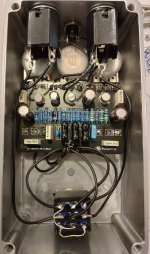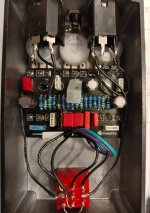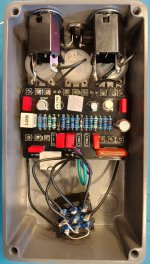I bought three Fuzz Aldrin PCBs, and built one stock (Lunar Module), and the two variants, Screw Driver and Hybrid Fuzz Drive. A huge thanks to @Chuck D. Bones for all the legwork in sorting out and posting the modifications!
I like all three, though I like the Screw Driver and Hybrid Fuzz Drive better. I'm trying to decide which of those two I like best. Right now I'm leaning a bit towards the Screw Driver, but haven't given them both enough side-by-side time to say for sure. I like the versatility, and the "vintage" voicing; I like dialing in a sound that's medium(ish) overdrive with a hint of the fuzz peppered in. To me, the settings I like best are kind of an amalgamation of a lot of classic rock tones, while at the same time being unique. I've only used them at home so far. I'm hoping they work equally well in a live band situation!
I used Tayda's pre-drilled enclosures. Note that the board calls for the "125B 5-Knob (Type 2)" enclosure, but Tayda only has "Type 1" pre-drilled. I went ahead and ordered the Type 1, but had to enlarge both middle holes: the top one to accommodate a pot (originally intended for an LED), and the lower one to accommodate the chrome LED holder. Doing this also makes the LED not line up correctly, so I soldered some longer wires onto my LED. Case drilling is my least favorite part of the pedal building process, so even with the extra bit of hacking I had to do, I'm still happy with the result.
Finally, a question: for anyone who's built the Screw Driver and/or Hybrid Fuzz Drive variants (or the Madbean Cosmopolitan, which by default is the Screw Driver): has anyone found a suitable silicon transistor that works well as a replacement for the AC127?
I am going to do another build (with the Madbean PCB) and socket the AC127, and see if I can find such a part. But if anyone has done any experimenting, I'd like to hear it. That's my only nit thus far, the reliance on the not-current-production germanium transistor.
Here are gut shots of my builds. I didn't take pics of the front (no fancy graphics, just solid color enclosure with labels from the label maker).
First, the stock Fuzz Aldrin (Lunar Module):

The Screw Driver:

Hybrid Fuzz Drive:

I like all three, though I like the Screw Driver and Hybrid Fuzz Drive better. I'm trying to decide which of those two I like best. Right now I'm leaning a bit towards the Screw Driver, but haven't given them both enough side-by-side time to say for sure. I like the versatility, and the "vintage" voicing; I like dialing in a sound that's medium(ish) overdrive with a hint of the fuzz peppered in. To me, the settings I like best are kind of an amalgamation of a lot of classic rock tones, while at the same time being unique. I've only used them at home so far. I'm hoping they work equally well in a live band situation!
I used Tayda's pre-drilled enclosures. Note that the board calls for the "125B 5-Knob (Type 2)" enclosure, but Tayda only has "Type 1" pre-drilled. I went ahead and ordered the Type 1, but had to enlarge both middle holes: the top one to accommodate a pot (originally intended for an LED), and the lower one to accommodate the chrome LED holder. Doing this also makes the LED not line up correctly, so I soldered some longer wires onto my LED. Case drilling is my least favorite part of the pedal building process, so even with the extra bit of hacking I had to do, I'm still happy with the result.
Finally, a question: for anyone who's built the Screw Driver and/or Hybrid Fuzz Drive variants (or the Madbean Cosmopolitan, which by default is the Screw Driver): has anyone found a suitable silicon transistor that works well as a replacement for the AC127?
I am going to do another build (with the Madbean PCB) and socket the AC127, and see if I can find such a part. But if anyone has done any experimenting, I'd like to hear it. That's my only nit thus far, the reliance on the not-current-production germanium transistor.
Here are gut shots of my builds. I didn't take pics of the front (no fancy graphics, just solid color enclosure with labels from the label maker).
First, the stock Fuzz Aldrin (Lunar Module):

The Screw Driver:

Hybrid Fuzz Drive:


